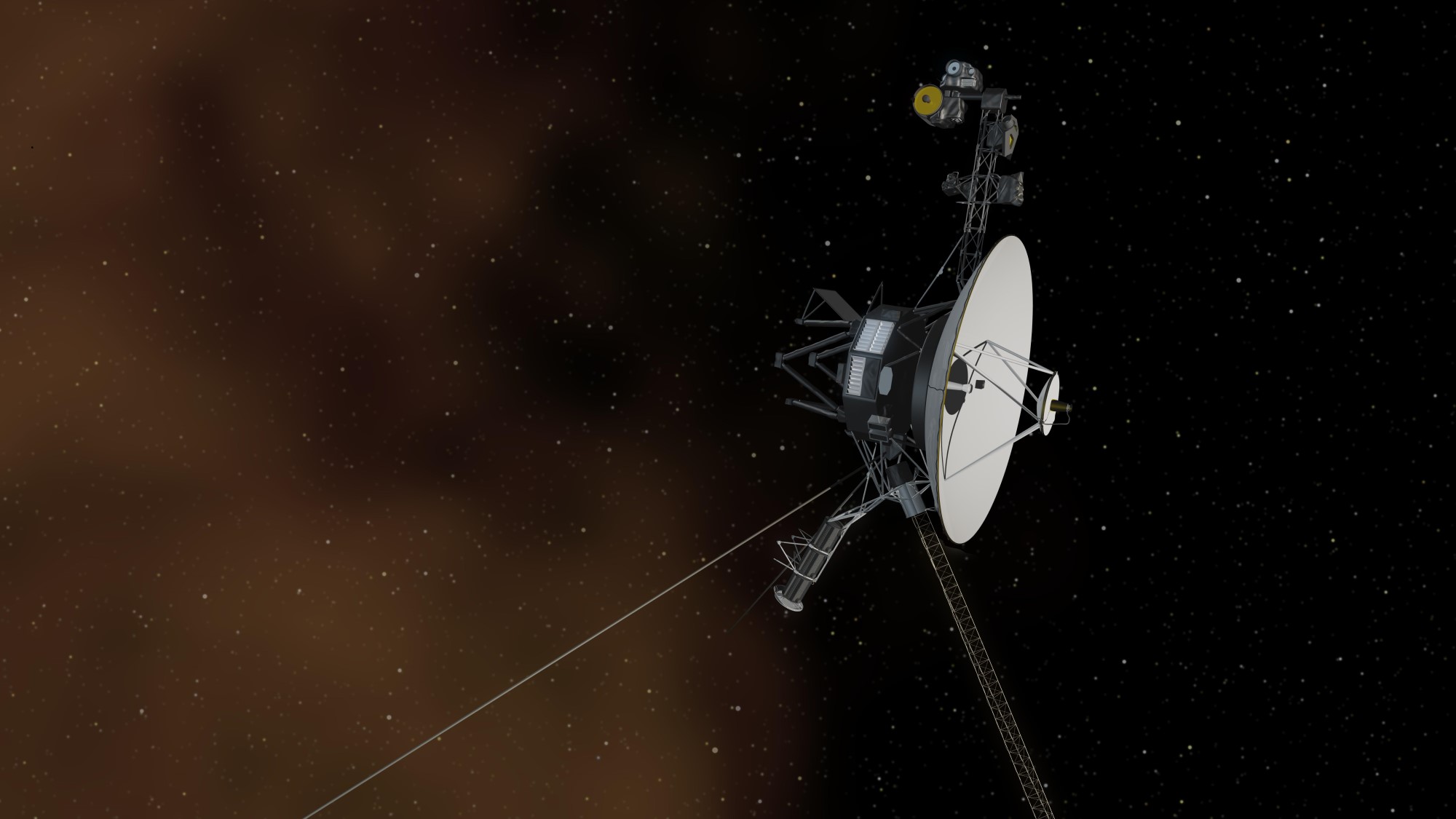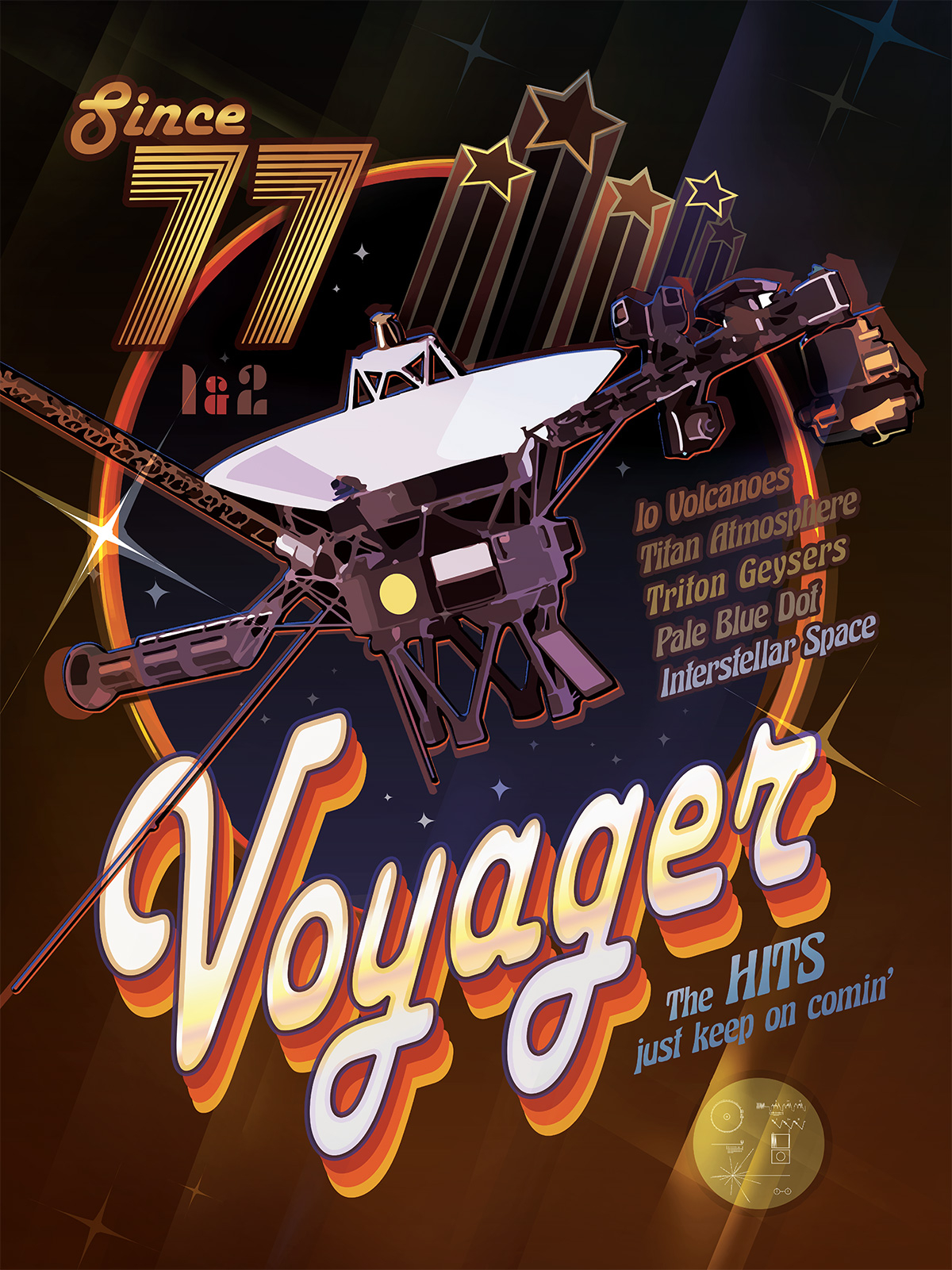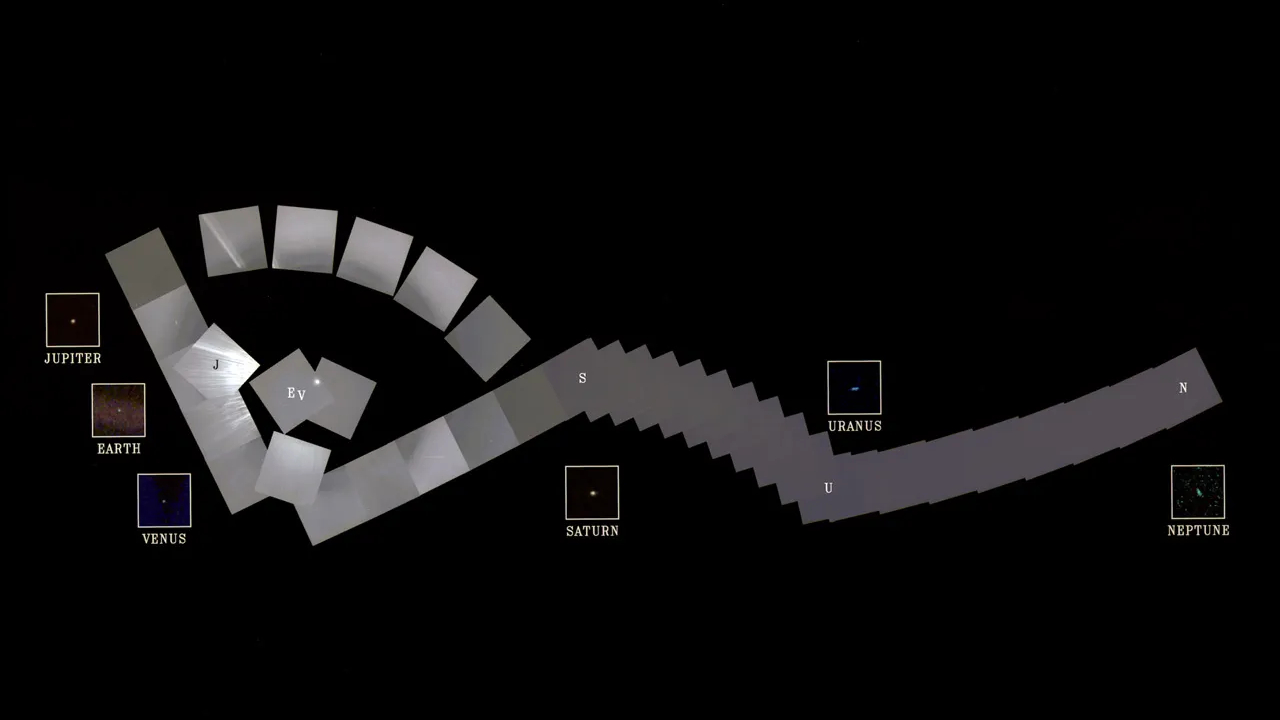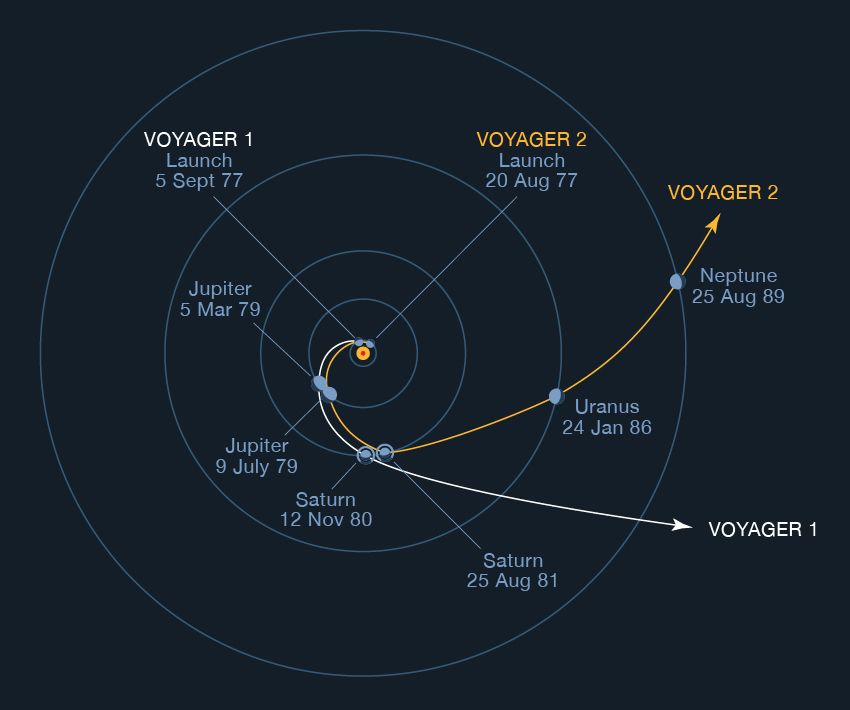NASA's Voyager 1 glitch has scientists sad yet hopeful: 'Voyager 2 is still going strong'
"If V1 didn't make it? I'd be very proud; the mission has far exceeded the designers' expectations."

It has been several months since one of humanity's most accomplished spacecraft, the Voyager 1 probe, stopped talking to us — and though they remain somewhat hopeful, Voyager mission scientists are preparing for the worst: A goodbye.
"Sad and frustrated to have the spacecraft still working, but muted," Bruce Waggoner, the Voyager mission assurance manager, told Space.com of the group's present morale. "Even though we know the end could come at any time, it's never easy to lose a spacecraft. Especially one like Voyager 1."
For more than 45 years, this boxy machine with a pearly white, conical disk that sort of makes it look like a giant loudspeaker in space has been sending back stunning data. And I mean stunning. Not only is it the first craft to enter interstellar space (and therefore the farthest human-made object ever), but it's also responsible for the identification of new Jovian moons, the discovery of yet another Saturnian ring and the solar system's first and only "family portrait" that includes our eclectic gang of planets.
Related: NASA's interstellar Voyager 1 spacecraft isn't doing so well — here's what we know
It's also why we have the powerful Pale Blue Dot image that resurfaces on the internet every so often to remind us of our insignificance, or rather, significance, depending on your perspective. As Carl Sagan famously said, "Look again at that dot. That's here. That's home. That's us."
All this time, Voyager 1's cosmic letters have come through as computer messages often do, with 0's and 1's in precise patterns. Through a little bit of handiwork, such sequences can be translated into words the human mind can grasp — and scientists were always excited to open a new package of Voyager 1's binary code.
But then, in September of last year, the 0's and 1's stopped making sense.
Breaking space news, the latest updates on rocket launches, skywatching events and more!
"Effectively, the call between the spacecraft and the Earth was still connected, but Voyager's 'voice' was replaced with a monotonous dial tone," the engineering team told Space.com.
Glitches have happened to Voyager 1 before, such as in 2022 when the probe's "attitude articulation and control system" exhibited some complications, but this one seems to be a doozy. The team still hasn't been able to fix it up, even months since the issue revealed itself, and is actually still searching for the crux of the problem.
So, is it time to call the final curtain on Voyager 1?
Well, to that end, scientists aren't quite sure yet. They remain working to remedy the situation — and quite diligently at that. "The team is tired because we have sustained a brisk pace for 3 months now, but we press on because we have ideas, and we have hope," Voyager mission engineer Kareem Badaruddin told Space.com.
However, what the team is sure of is that even if Voyager 1 succumbs to its wounds, the voyage is certainly not over.
"Don't forget Voyager 2 is still going strong! If we can keep one spacecraft going, the mission will continue," the crew said.
Voyager 2, which looks an awful lot like Voyager 1, actually launched 16 days before its counterpart, on Aug. 20, 1977. Voyager 1 just happened to get farther faster because it had a more efficient route out of the asteroid belt, officially overtaking its partner on Dec. 15, 1977 and later becoming the first probe to exit the gravitational influence of our solar system. Voyager 2 does have a bunch of achievements under its own belt, though, such as the fact that it's still the only spacecraft to have visited the outer planets, Uranus and Neptune.
Together, the Voyagers' joint mission was to simply explore — to plunge through the solar system, sweep across moons and planets beyond our own and try to go where no spacecraft has gone before.
"The Voyagers are the only spacecraft exploring interstellar space in-situ, and there are no missions that can gather this same data remotely," the team said.
They've surely been doing their duty, and hopefully, Voyager 1 has a little more juice left. But even if it doesn't, scientists wish to make clear that Voyager 2 shall continue to keep the torch lit.
Voyager 1's medical chart
In December of 2023, the Voyager 1 team announced that the spacecraft's malfunction lies with its Flight Data System, or FDS, which is one of its onboard computers. There used to be a backup FDS, but that stopped working in 1981.
"Because of this issue, scientists are not receiving any science data or updates about the probe's health and status, including information that might reveal the source of the problem," the team explains.
Here's where perhaps the greatest trouble with this dilemma comes in. One of the FDS' main jobs is to basically keep Voyager 1's medical records up to date, then work with what's known as the telemetry modulation unit, or TMU, to tell ground control what's going on. But, because the FDS itself is the one malfunctioning, that medical record transmission can't happen.
"The team has attempted various 'simple' fixes, such as resetting the FDS to the state it was in before the issue began," the engineers said. "This week, the team will send more commands to the spacecraft to gather information about the status of the onboard systems. In the coming weeks, the team expects to start making more aggressive attempts to reset various systems that might influence the FDS."
As of now, the team believes one possible cause of the issue has to do with the FDS' memory being corrupted by some mechanism that leads its binary code to sprout unintelligible patterns. However, engineers are also considering the fact that it could be a physical hardware failure. After all, Voyager 1's mechanics have been toiling away for multiple decades. Something could've simply broken down, hardware- or software-wise. In fact, scientists beamed some preemptive software patches to both of the Voyagers last year, from billions of miles away.
"The anomaly has caused us to study and learn about the spacecraft — much knowledge that was forgotten because it wasn't needed for many years has been recovered," Badaruddin said.
In a slightly more far-fetched scenario, the team also suggests it's possible some sort of energetic particle could've smashed into the spacecraft. If that happened, it might've created what's known as a "bit flip," which means a 0 in the code accidentally became a 1, or vice versa.
Still, the team is leaving all possibilities open. That's because, in truth, it might not even be the FDS that's causing problems in the first place. This theory is just the most likely one to stem from data the engineers currently have. "Because no engineering data is coming back, it's very hard to isolate the source of the problem" they said.
Moreover, in a bit of a non-silver lining, remember how Voyager 1's greatest achievement is being the first-ever probe to venture into interstellar space, where it's surrounded by untouched stardust and blankets of darkness? Yeah, it's extremely far away from us. And that means communicating with it takes a very (very) long time. Specifically, at the time of writing this article, Voyager 1 is more than 162 AUs away from Earth; one AU is equal to the distance between our planet and the sun. In total, it takes approximately 45 hours to complete one back-and-forth command with this spacecraft. Thus, "this process may take months," the team said.
To give you a silver lining, though, the scientists have confirmed that Voyager 1 is exhibiting what's known as a carrier tone, which runs along a wavelength that doesn't carry information but rather acts as a heartbeat. At the very least, we know it is alive.
"The spacecraft appears to be healthy other than the current issue. So if we can fix this, Voyager 1 should be able to continue its science mission," the team said. "But the Voyagers are already operating far, far beyond what anyone expected of them. We know the more time that goes by, the more issues are likely to arise. We’ll keep them going as long as we can, but we know they won't last forever."
"If V1 didn't make it? I'd be very proud; the mission has far exceeded the designers' expectations," Badaruddin said. "But really, that's hard to ponder because we still believe we can recover."
Alas, fingers crossed that Voyager 1 returns to its healthy self — but even if it doesn't, and is left alone to drift in space, we can be sure its legacy has already been firmly cemented in our books, in our hearts and in our history.
Then, it'll be up to you, Voyager 2.

Monisha Ravisetti is Space.com's Astronomy Editor. She covers black holes, star explosions, gravitational waves, exoplanet discoveries and other enigmas hidden across the fabric of space and time. Previously, she was a science writer at CNET, and before that, reported for The Academic Times. Prior to becoming a writer, she was an immunology researcher at Weill Cornell Medical Center in New York. She graduated from New York University in 2018 with a B.A. in philosophy, physics and chemistry. She spends too much time playing online chess. Her favorite planet is Earth.





